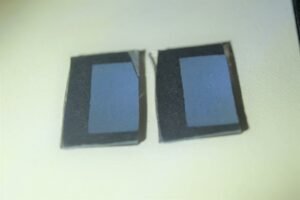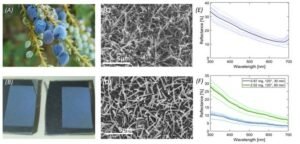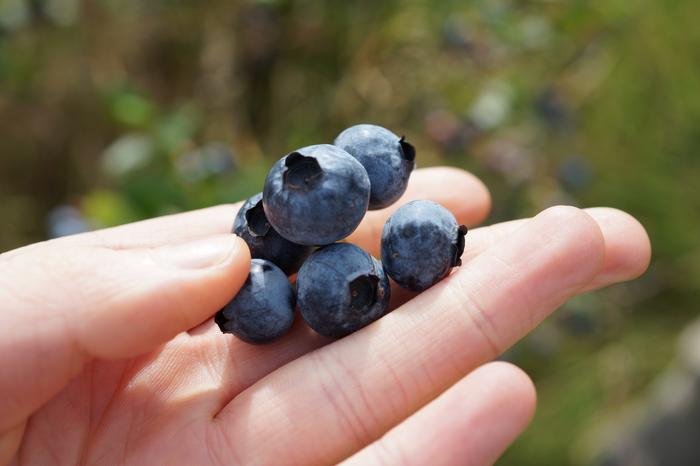A team of scientists from the University of Bristol’s School of Biological Sciences says they have finally solved the millennia-old mystery of why blueberries are blue.
The answer, they say, lies in tiny crystalline structures hidden within the berry’s wax outer coating that reflects light in a specific way to make them appear blue as opposed to the reddish color of the pigments found in their fruit skin. This also applies to other blue foods like damsons, sloe, and juniper berries.
The same research team also says they have been able to reproduce the blue-light-reflecting crystals outside of the berry. Next, they plan to look into the possibility of creating an advanced coloring pigment that is environmentally safe, potentially edible, and may even be adapted to offer some of the added benefits found in the waxy coating of blueberries, such as protection from moisture and self-cleaning.
Solving the Mystery of Blueberries
If you ask a philosopher why the sky is blue, you might receive an unexpected answer. However, if you asked a scientist, you would likely learn that the Earth’s atmosphere reflects the other lights of the spectrum back into space while allowing the blue part of the sunlight through.
Perhaps surprisingly, if you asked a scientist why blueberries are blue, their answer would likely be of little more use than the philosopher’s answer about the sky. Maybe even less so. At least, not until recently.
Now, a team of researchers are reporting they have solved the mystery of the blueberries. And unlike beauty, it is not even skin deep.
The Waxy Coating That Reflects The Blue Light
In their study, Self-assembled, Disordered Structural Colour from Fruit Wax Bloom’, which was published in the journal Science Advances, University of Bristol Research Fellow Rox Middleton and colleagues describe how they went about solving the millennia-old mystery.
“The blue of blueberries can’t be ‘extracted’ by squishing – because it isn’t located in the pigmented juice that can be squeezed from the fruit,” Middleton explained. “That was why we knew that there must be something strange about the colour.”
On a hunch, the team looked at the wax coating on the surface of the blueberry. This type of coating, they note, is present on the surface of many types of plants. Some research has shown it can be very effective as a hydrophobic, self-cleaning coating. But according to the researchers, this type of plant wax coating “has multiple functions, many of which scientists still don’t understand.”
In hopes that one of these unknown functions was to give blueberries their blue color, the team decided to test the idea in a lab. Almost immediately, the mystery was solved.
“So we removed the wax and re-crystallized it on the card, and in doing so, we were able to create a brand new blue-UV coating,” said Middleton.


Upon further analysis, the team found that the chromatic blue-UV reflectance in blueberries “arises from the interaction of the randomly arranged crystal structures of the epicuticular wax with light.” In effect, the wax coating on the outside of blueberries was making them blue.
The researchers say the particular reflectance in blueberries gives them their blue appearance to humans and makes them appear as blue-UV to birds. The latter, they note, could be an evolutionary adaptation
“It shows that nature has evolved to use a really neat trick, an ultrathin layer for an important colorant,” said Middleton.


Study Could Lead to a Versatile New Blue Colorant
Although the recrystallized wax coating created by the research team is not quite as reflective as the natural coating on blueberries, they say it is clearly blue in color and reflects UV light well. In fact, the researchers hope that their work could lead to the development of all new types of paints, dyes, or other colorants that are environmentally friendly, potentially edible, and may even impart some of the other benefits found in plants’ natural wax coatings.
“Building all that functionality of this natural wax into artificially engineered materials is the dream!” said Middleton.
And while the team sees the potential commercial applications of their work, they are clearly excited at having solved a mystery that had remained unsolved for so long.
“It was really interesting to find that there was an unknown coloration mechanism right under our noses on popular fruits that we grow and eat all the time,” said Middleton. “It was even more exciting to be able to reproduce that colour by harvesting the wax to make a new blue coating that no one’s seen before.”
Christopher Plain is a Science Fiction and Fantasy novelist and Head Science Writer at The Debrief. Follow and connect with him on X, learn about his books at plainfiction.com, or email him directly at christopher@thedebrief.org.

